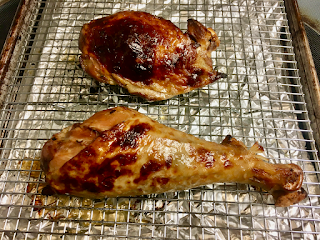18 May 2021
Recipe from Cook's Country, August 2017
There are many different styles of pizza so I guess it shouldn't have been a surprise when I learned of another from an episode of Cook's Country on TV. It's a pan pizza baked in a square pan as created at the Detroit restaurant Buddy's Rendezvous in 1946. Some changes had to be made to the original recipe so it could be made at home anywhere in the country. I won't be able to compare it to the original but I can try it to see if it is any good.
A 13x9-inch baking pan was sprayed with vegetable oil then olive oil was brushed on the bottom and sides. All-purpose flour, yeast, and sugar were whisked together in the bowl of a stand mixer. With the mixer running, room-temperature water (I always use bottled water for bread dough) was added and mixed until no dry flour remained. The dough was covered and let stand for about 10 minutes. Then, salt was added and the dough was kneaded in the mixer. It was turned out onto a counter and kneaded to form a ball of dough, adding bench flour as needed so the sticky dough could be handled. The dough was placed in the prepared baking pan and allowed to rest for about 15 minutes before being stretched to fill the pan. The dough rose until roughly triple in volume, about 2½ hours. Meanwhile, the sauce was created by mixing canned crushed tomatoes, olive oil, chopped fresh basil, minced garlic, dried oregano, dried basil, sugar, pepper, and salt. I couldn't find a small can of crushed tomatoes so used "petite-cut tomatoes" that I mashed and drained. When the dough was ready it was covered with grated Monterey Jack cheese then the sauce was applied in three stripes. The pizza was baked in a 500° oven for about 15 minutes, cooled for 5, then served. Total time, mostly hands off, was just under 3½ hours.
This is good pizza and worth having regularly. The crust is crispy and chewy and the sauce is flavorful and bright and there is just the right amount. We had two dinners and a lunch from this pizza. The amount of time invested to create it is reasonable since most of it is hands off. It is good left over, reheated in a covered skilled to crisp up the crust and melt the cheese.



















